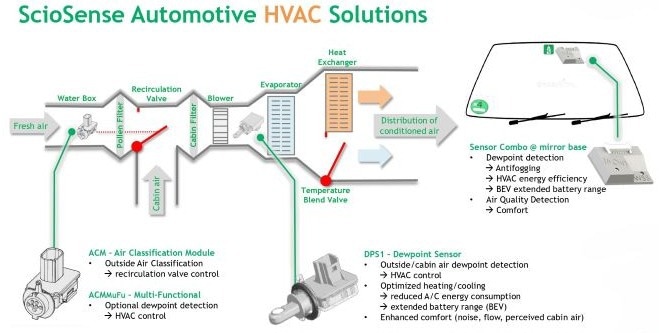Sensors survey crucial areas in electric vehicles, including battery condition, indoor climate, and air quality. They contribute to enhanced safety, higher energy efficiency, and more comfort. When combined with other smart technologies, they also increase vehicle range.

Image Credit: ScioSense
Electromobility is becoming more widespread in many areas of the world. New vehicles are coming to market in increasingly truncated development cycles, distinguishing themselves from the competition with longer ranges, smart functions, and novel comfort features.
Owing to e-mobility's innovation-first nature, new players are catching up to established industry leaders by building novel technologies and bringing them to market quickly and with versatility.
Essential technological drivers underlying development toward increasingly smart electric vehicles are highly efficient computers, which increasingly optimize and automate the driving experience, and sophisticated sensors, which deliver the required raw data. Without precise collection and processing of key data, it would not be possible to realize the vision of the smart, sustainable vehicle of the future.
Recognizing Critical Battery Conditions at an Early Stage
An example of the crucial role of sensors in electric vehicles is tracking battery status via metal oxide (MOX) sensors. Stringent regulatory criteria apply to batteries in electric vehicles to secure passengers’ safety. Simultaneously, the batteries undergo high stress levels during rapid charging and discharging. In certain instances, this may lead to a fire in case of a defect or damage from an accident.

Image Credit: ScioSense
Complying with the United Nations Global Technical Regulation on Electric Vehicle Safety (EVS), battery manufacturers and OEMs should ensure that drivers and passengers can leave the vehicle in such events before a fire or, at worst, a battery explosion.
Uncontrolled heat development stemming from critical battery conditions should be identified early on. Broadband gas sensors for metal oxides (MOX) are optimally suited as they can detect the development and outgassing of hydrogen, carbon monoxide, and organic solvents in a chemical reaction before thermal runaway can occur.
In independent experiments, the specially engineered BCM1 sensor module from ScioSense for condition monitoring of Li-ion batteries reacted up to 40 seconds faster than temperature and battery voltage sensors. In an ideal scenario, these sensors would be integrated into the battery’s modules so that problems can be recognized before spreading to the whole battery of the vehicle (thermal propagation). This facilitates fast countermeasures and early warning of the occupants.

Image Credit: ScioSense
Optimized Climate Control Increases Range
Air quality and environmental sensors are critical in air conditioning electric vehicles. The goal of tracking the interior climate is to optimally manage temperature via smartly controlled outdoor and indoor air circulation while simultaneously preventing windows from fogging. When cooling the vehicle at warm outside temperatures, the sensors also ensure that the air conditioning compressor’s performance and heat pump are optimally coordinated to obtain the most ideal cabin climate with the lowest possible energy consumption.
As such, air quality and environmental sensors allow optimizing the vehicle’s temperature and humidity, thus increasing comfort. They simultaneously help boost the air conditioning system’s efficiency, which reduces energy consumption and directly impacts the vehicle's range.
An independent study by “Car and Driver Magazine” in 2020 identified variations of up to 13 percent in an electric vehicle's battery range dependent on air conditioning settings. This demonstrates the importance of monitoring and data collection by sensors in the air conditioning system and vehicle cabin.
Sensors Working Together
In an ideal scenario, data from multiple sensors is merged in a smart system to optimize climate control: Modules for identifying the outside air are utilized to regulate air inlet valves and mixers with the recirculated cabin air, alongside optional dew point detection.
Sensors upstream of the air conditioning compressor assess the air’s temperature and humidity, which are soon released into the cabin. Additional sensors can support the data, which are installed at different positions in the passenger area or directly on the windscreen. This facilitates individual fine-tuning of the air conditioning or dependable and energy-saving windscreen defogging.
Fully Automatic Air Quality Control
Air quality monitoring goes even further with an in-demand comfort function, especially in the luxury segment. Intelligent sensors assess a vehicle’s air quality and surrounding environment to automatically regulate the air conditioning system.
ScioSense has built a reference design based on MOX sensors that assesses the concentration of airborne volatile organic compounds (VOCs), allowing it to draw conclusions about air quality.
Unpleasant environmental odors stemming from exhaust fumes, industrial plants, or agriculture, for example, can be detected alongside odors from food or cigarette smoke indoors. By comparing the air quality, systems can automatically regulate air exchange and circulation alongside active air purification. The result is optimized air quality in the passenger compartment with minimal energy expenditure.

Image Credit: ScioSense
Challenges for OEM Integration
Condition monitoring for e-car batteries is already a crucial safety feature, and its significance is growing alongside the demand for increasingly powerful batteries and faster charging speeds. Sensors for air and environmental monitoring have superb potential for controlling climate in e-mobility, as the efficiency of heat and ventilation management directly affects the range of the vehicles.
Owing to stringent safety criteria, ever-shorter innovation cycles, and sometimes complicated certification processes, suppliers and vehicle manufacturers in the automotive industry are advised to deal with smart sensors and their design-in early on. It also makes sense to be ready when the sensors become a standard industry requirement. Factors, including energy efficiency and range, are key aspects for vehicle manufacturers to consider to fare well against global competition.
ScioSense supports companies worldwide in introducing new technology to their workflows. It has over 25 years of experience in the automotive sensor technology sector.
Customers and partners can benefit from the rapid and versatile development of customized product variants and integration support from the engineering team at seven locations globally, with headquarters in the Netherlands and a local-for-local approach for direct contact between customers and the development team.

This information has been sourced, reviewed and adapted from materials provided by ScioSense.
For more information on this source, please visit ScioSense.